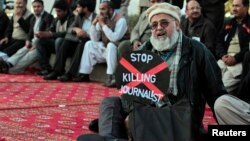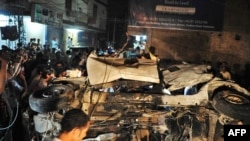The Taliban has dissociated itself; the Pakistan Army has extended its condolences; and government functionaries, politicians, and civil-society representatives have offered condolences as "unidentified" armed men took the life of another journalist in Pakistan's perilous tribal areas on February 27.
Malik Mumtaz, who was reporting from Miranshah, North Waziristan, for Pakistan's "The News International" and Geo television, was gunned down while on his way home from a funeral in a nearby village.
He thus became the 11th tribal journalist killed in armed attacks or bomb blasts since February 7, 2005.
[Police in Pakistan’s southwest Balochistan Province reported a 12th death on March 2, saying attackers on a motorcycle had shot dead local journalist Mahmud Afridi. Senior police officer Ahmed Shah Lango said Afridi was killed on March 1 as he walked to a press club in the town of Kalat, some 150 kilometers south of the provincial capital, Quetta. Lango said Afridi worked for the local Intikhab newspaper and was president of the Kalat press club. His friend and colleague Nowroz Mengal told Radio Mashaal that it did not appear that Afridi had ever received any threats. No one has claimed the responsibility of his killing.]
The New York-based Committee to Protect Journalists (CPJ) has described Pakistan as "one of the deadliest nations in the world for the press," where "the government is unwilling to confront the problem."
According to CPJ, as many as 51 journalists have been killed in Pakistan since 1992 but the government has failed to arrest and punish their killers.
Apart from the abduction and execution of "Wall Street Journal" reporter Daniel Pearl in 2002 in Pakistan's commercial capital, Karachi, the killings of tribal journalist Hayatullah Khan, Asia Online correspondent Saleem Shahzad, and Geo TV reporter Wali Khan Babar are all examples of the government's inability to hold accountable those responsible for journalist slayings.
GRAPHIC: Tribal journalists killed in Pakistan since 2005:
Before his bullet-riddled body was found handcuffed in North Waziristan on June 16, 2006, tribal journalist Hayatullah Khan was kidnapped and kept in captivity for several weeks.
After protests from journalist associations in and outside Pakistan, a judicial commission was formed to investigate his death. However, that commission's report never saw the light of day, and it's unclear why. Khan's kidnappers and killers remain "unidentified."
Geo TV's Babar was shot dead in Karachi on January 13, 2011. Geo TV officials claim that witnesses in Babar's murder case were killed one by one by "unidentified" armed men, while prosecutors and police officers investigating the case have received anonymous threats. The case remains stalled two years after the slaying.
Asia Online's Shahzad was kidnapped in the Pakistani capital, Islamabad, on May 30, 2011, and his bruised body was found a day later in the town of Mandi Bahauddin, in Punjab Province.
After countrywide protests from journalists, the government formed a judicial commission to investigate the Shahzad case. The commission's findings, released six months later, were heavily criticized as overly vague. One paragraph of the report states: "Despite extensive efforts by the commission, it was unable to identify the culprits due to a lack of significant evidence."
Now comes the task of investigating the killing of Mumtaz and arresting the culprits, as promised by the Pakistani authorities in their statements of condemnation.
The Tehrik-e-Taliban Pakistan (TTP) spokesman denied responsibility for the murder and condemned the killing, and the Pakistan Army also expressed condolences.
In the majority of targeted killings or kidnappings of journalists, fingers are raised at both nonstate and state actors -- meaning militants and the Pakistani security agencies, respectively. In North Waziristan, the two parties holding what is arguably the greatest sway are the security agencies and the various Taliban groups. Who is responsible, if neither of those two?
Seasoned Pakistani journalist Najam Sethi, commenting during his evening show "Aapas Ki Baat" on Geo TV on February 27, suggested the killers want to communicate the message that those in the media should be careful (when reporting on sensitive issues). But on the more basic question of who the killers are, Sethi -- whose program is known for bold predictions of political developments -- remained silent.
As is often the case, the next few days will see protests by journalists across Pakistan at the killing, as well as promises from Pakistani officials about bringing the culprits to justice. But the key question will remain unresolved until the culprits are actually identified and brought to justice.
Unfortunately, just as when unidentified perpetrators kidnapped and killed Shahzad nearly two years ago, it bears repeating that while Mumtaz is the latest on the list of slain Pakistani journalists he certainly won't be the last.
Malik Mumtaz, who was reporting from Miranshah, North Waziristan, for Pakistan's "The News International" and Geo television, was gunned down while on his way home from a funeral in a nearby village.
He thus became the 11th tribal journalist killed in armed attacks or bomb blasts since February 7, 2005.
[Police in Pakistan’s southwest Balochistan Province reported a 12th death on March 2, saying attackers on a motorcycle had shot dead local journalist Mahmud Afridi. Senior police officer Ahmed Shah Lango said Afridi was killed on March 1 as he walked to a press club in the town of Kalat, some 150 kilometers south of the provincial capital, Quetta. Lango said Afridi worked for the local Intikhab newspaper and was president of the Kalat press club. His friend and colleague Nowroz Mengal told Radio Mashaal that it did not appear that Afridi had ever received any threats. No one has claimed the responsibility of his killing.]
The New York-based Committee to Protect Journalists (CPJ) has described Pakistan as "one of the deadliest nations in the world for the press," where "the government is unwilling to confront the problem."
According to CPJ, as many as 51 journalists have been killed in Pakistan since 1992 but the government has failed to arrest and punish their killers.
Apart from the abduction and execution of "Wall Street Journal" reporter Daniel Pearl in 2002 in Pakistan's commercial capital, Karachi, the killings of tribal journalist Hayatullah Khan, Asia Online correspondent Saleem Shahzad, and Geo TV reporter Wali Khan Babar are all examples of the government's inability to hold accountable those responsible for journalist slayings.
GRAPHIC: Tribal journalists killed in Pakistan since 2005:
Before his bullet-riddled body was found handcuffed in North Waziristan on June 16, 2006, tribal journalist Hayatullah Khan was kidnapped and kept in captivity for several weeks.
After protests from journalist associations in and outside Pakistan, a judicial commission was formed to investigate his death. However, that commission's report never saw the light of day, and it's unclear why. Khan's kidnappers and killers remain "unidentified."
Geo TV's Babar was shot dead in Karachi on January 13, 2011. Geo TV officials claim that witnesses in Babar's murder case were killed one by one by "unidentified" armed men, while prosecutors and police officers investigating the case have received anonymous threats. The case remains stalled two years after the slaying.
Asia Online's Shahzad was kidnapped in the Pakistani capital, Islamabad, on May 30, 2011, and his bruised body was found a day later in the town of Mandi Bahauddin, in Punjab Province.
After countrywide protests from journalists, the government formed a judicial commission to investigate the Shahzad case. The commission's findings, released six months later, were heavily criticized as overly vague. One paragraph of the report states: "Despite extensive efforts by the commission, it was unable to identify the culprits due to a lack of significant evidence."
Now comes the task of investigating the killing of Mumtaz and arresting the culprits, as promised by the Pakistani authorities in their statements of condemnation.
The Tehrik-e-Taliban Pakistan (TTP) spokesman denied responsibility for the murder and condemned the killing, and the Pakistan Army also expressed condolences.
In the majority of targeted killings or kidnappings of journalists, fingers are raised at both nonstate and state actors -- meaning militants and the Pakistani security agencies, respectively. In North Waziristan, the two parties holding what is arguably the greatest sway are the security agencies and the various Taliban groups. Who is responsible, if neither of those two?
Seasoned Pakistani journalist Najam Sethi, commenting during his evening show "Aapas Ki Baat" on Geo TV on February 27, suggested the killers want to communicate the message that those in the media should be careful (when reporting on sensitive issues). But on the more basic question of who the killers are, Sethi -- whose program is known for bold predictions of political developments -- remained silent.
As is often the case, the next few days will see protests by journalists across Pakistan at the killing, as well as promises from Pakistani officials about bringing the culprits to justice. But the key question will remain unresolved until the culprits are actually identified and brought to justice.
Unfortunately, just as when unidentified perpetrators kidnapped and killed Shahzad nearly two years ago, it bears repeating that while Mumtaz is the latest on the list of slain Pakistani journalists he certainly won't be the last.

